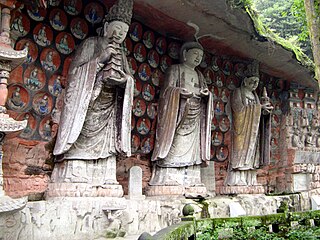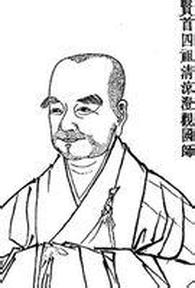
Wŏnhyo was one of the most important philosophers and commentators in East Asian Buddhism and the most prolific scholar in Korean Buddhism. As one of the most eminent scholar-monks in East Asian history, his extensive literary output runs to over 80 works in 240 fascicles. His most influential commentaries are those on buddha-nature texts like the *Vajrasamādhisūtra, the Awakening of Faith, and the Mahāparinivāṇasūtra. These works became classics widely respected throughout Korea, China and Japan.

The Huayan school of Buddhism is Mahayana Buddhist tradition that developed in China during the Tang dynasty (618-907). The Huayan worldview is based primarily on the Buddhāvataṃsaka Sūtra as well as on the works of Huayan patriarchs, like Zhiyan (602–668), Fazang (643–712), Chengguan (738–839), Zongmi (780–841) and Li Tongxuan (635–730).

East Asian Yogācāra refers to the traditions in East Asia which developed out of the Indian Buddhist Yogācāra systems. In East Asia, this school of Buddhist idealism was known by the names: "Consciousness-Only school" and "Dharma Characteristics school" traditional Chinese: 法相宗; ; pinyin: Fǎxiàng-zōng; Japanese pronunciation: Hossō-shū; Korean: 법상종).

Korean Buddhism is distinguished from other forms of Buddhism by its attempt to resolve what its early practitioners saw as inconsistencies within the Mahayana Buddhist traditions that they received from foreign countries. To address this, they developed a new holistic approach to Buddhism that became a distinct form, an approach characteristic of virtually all major Korean thinkers. The resulting variation is called Tongbulgyo, a form that sought to harmonize previously arising disputes among scholars.

The Kwan Um School of Zen (관음선종회) (KUSZ) is an international school of zen centers and groups founded in 1983 by Zen Master Seung Sahn. The school's international head temple is located at the Providence Zen Center in Cumberland, Rhode Island, which was founded in 1972 shortly after Seung Sahn first came to the United States. The Kwan Um style of Buddhist practice combines ritual common both to Korean Buddhism as well as Rinzai school of Zen, and their morning and evening services include elements of Huayan and Pure Land Buddhism. While the Kwan Um Zen School comes under the banner of the Jogye Order of Korean Seon, the school has been adapted by Seung Sahn to the needs of Westerners. According to James Ishmael Ford, the Kwan Um School of Zen is the largest Zen school in the Western world.
The Vajrasamadhi-sutra is the reconstructed Sanskrit title of a Buddhist sutra ascribed to Shakyamuni Buddha but produced in Korea under the name Kumgang sammae kyong, or the Adamantine Absorption Sutra. Although it was originally believed to have been a Chinese translation from a Sanskrit text, scholars have recently found that it was produced in Korea in about 685 CE and that it may be connected with the emergence of Seon in Korea.

Hwaeomsa is a head temple of the Jogye Order of Korean Buddhism. It is located on the slopes of Jirisan, in Masan-myeon, Gurye County, in South Jeolla Province, South Korea.

Fazang (643–712) was a Chinese Buddhist scholar, translator, and religious leader of the Tang dynasty. He was the third patriarch of the Huayan school of East Asian Buddhism, a key figure at the Chinese Imperial Court, and an influential Chinese Buddhist philosopher. Some scholars see him as the main figure in or even de facto founder of the Huayan school. Fazang's ancestors came from the Central Asian region of Sogdia, a major center for Silk Road trade, but he was born in the Tang capital of Chang'an, where his family had become culturally Chinese.
Zen master is a somewhat vague English term that arose in the first half of the 20th century, sometimes used to refer to an individual who teaches Zen Buddhist meditation and practices, usually implying longtime study and subsequent authorization to teach and transmit the tradition themselves.

Qingliang Chengguan, was an important scholar-monk and patriarch of the Huayan school of Chinese Buddhism also known as Huayan pusa and Qingliang Guoshi.

Seon or Sŏn Buddhism is the Korean name for Chan Buddhism, a branch of Mahāyāna Buddhism commonly known in English as Zen Buddhism. Seon is the Sino-Korean pronunciation of Chan an abbreviation of 禪那 (chánnà), which is a Chinese transliteration of the Sanskrit word of dhyāna ("meditation"). Seon Buddhism, represented chiefly by the Jogye and Taego orders, is the most common type of Buddhism found in Korea.
The schools of Mahayana Buddhism developed several different schemes of doctrinal classification.

Buseoksa Temple is a Buddhist temple located near Mt. Bonghwang in Buseok-myeon, Yeongju City, Gyeongsangbuk-do, founded by the prominent scholar-monk Uisang in 676, the 16th year of Munmu of Silla. Buseoksa temple is also well known as the "Temple of the Floating Stone".
The Six Schools of Nara Buddhism, also known as the Rokushū 六宗, were academic Buddhist sects. These schools came to Japan from Korea and China during the late 6th and early 7th centuries. All of these schools were controlled by the newly formed Japanese government of Nara. These schools were installed to mimic and expand upon already existing mainland Asian Buddhist thought.
Gyunyeo or Kyun Yeo was a Korean Buddhist monk and poet. He came from the Hwangju Byeon clan and his hometown was Hwangju. Among his works are the first extant collection of poetry in Korean, Songs of the Ten Vows Samantabhara, which can be found in The Life of Kuehne.

Daehaeng Kun Sunim was a Korean Buddhist nun and Seon (禪) master. She taught monks as well as nuns, and helped to increase the participation of young people in Korean Buddhism. She made laypeople a particular focus of her efforts, and broke out of traditional models of spiritual practice, teaching so that anyone could practice, regardless of monastic status or gender. She was also a major force for the advancement of Bhikkunis (nuns), heavily supporting traditional nuns’ colleges as well as the modern Bhikkuni Council of Korea. The temple she founded, Hanmaum Seon Center, grew to have 15 branches in Korea, with another 10 branches in other countries.
The Beopseongge or Hwaeom ilseung beopgye do is a Buddhist text created by Uisang, Korean monk of the Silla period. The title is rendered in English as "The Song of Dharma Nature". This monumental script is widely known to many Korean Seon Buddhism and Japanese zen and Chinese chan. Beopseongge is recorded on not only Tripitaka Koreana in Korea but Taishō Tripiṭaka in Japan.
Jikji is a 2005 South Korean Mini series starring Han Min and Kim Jin-keun. It aired on MBC on Saturday, 3 December 2005 at 21:40 until 01:10. This series aired as an HD special drama for the 44th anniversary of MBC's founding.

The history of Chinese Buddhism begins in the Han dynasty, when Buddhism first began to arrive via the Silk Road networks. The early period of Chinese Buddhist history saw efforts to propagate Buddhism, establish institutions and translate Buddhist texts into Chinese. The effort was led by non-Chinese missionaries from India and Central Asia like Kumarajiva and Paramartha well as by great Chinese pilgrims and translators like Xuanzang.











